
A gurdwara or gurudwara is a place of assembly and worship for Sikhs but its normal meaning is place of guru or "Home of guru". Sikhs also refer to gurdwaras as Gurdwara Sahib. People from all faiths and religions are welcomed in gurdwaras. Each gurdwara has a Darbar Sahib where the Guru Granth Sahib is placed on a takht in a prominent central position. Any congregant may recite, sing, and explain the verses from the Guru Granth Sahib, in the presence of the rest of the congregation.
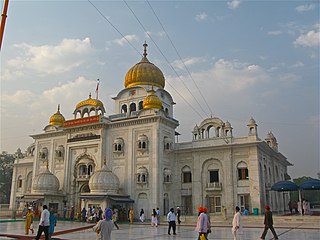
Gurdwara Bangla Sahib is one of the most prominent Sikh gurdwaras, or Sikh house of worship, in Delhi, India, and known for its association with the eighth Sikh Guru, Guru Har Krishan, as well as the holy pond inside its complex, known as the "Sarovar." It was first built as a small shrine by Sikh General Sardar Baghel Singh in 1783, on the bungalow donated by king Raja Jai Singh of Amer, who supervised the construction of nine Sikh shrines in Delhi in the same year, during the reign of Mughal Emperor, Shah Alam II.
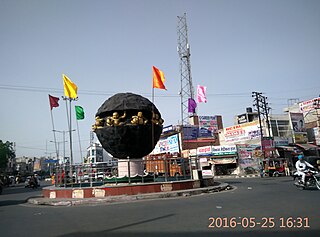
Kaithal is a city and municipal council in the Kaithal district of the Indian state of Haryana. Kaithal was previously a part of Karnal district and later, Kurukshetra district until 1 November 1989, when it became the headquarters of the Kaithal. It shares a border with the Patiala district of state Punjab and the Kurukshetra, Jind and Karnal districts of Haryana. Kaithal district is situated in the North-West of the Haryana state. Its North-West boundaries, which include Guhla-Cheeka are attached to Punjab.

Anandpur Sahib, also referred simply as Anandpur, is a city in Rupnagar district (Ropar), on the edge of Shivalik Hills, in the Indian state of Punjab. Located near the Sutlej River, the city is one of the most sacred religious places in Sikhism, being the place where the last two Sikh Gurus, Guru Tegh Bahadur and Guru Gobind Singh, lived. It is also the place where Guru Gobind Singh founded the Khalsa Panth in 1699. The city is home to Takhat Sri Kesgarh Sahib, the third of the five Takhts in Sikhism.

The Takht Sri Darbar Sahib Damdama Sahib, is one of the five takhts or Seat of Temporal Authority of Sikhism, located in Talwandi Sabo, near the city of Bathinda in Bathinda district of Punjab, India. At this place Guru Gobind Singh, the tenth Sikh Guru, prepared the full version of the Sikh scriptures called Sri Guru Granth Sahib in 1705. The other four Takhts are the Akal Takht, Takht Sri Keshgarh Sahib, Takht Sri Patna Sahib and Takht Sri Hazur Sahib.

Chamkaur Sahib is a Sub Divisional town in the district of Rupnagar in the Indian State of Punjab.

Gurdwara Sis Ganj Sahib is one of the nine historical Gurdwaras in Delhi. It was first constructed in 1783 as a small shrine by Baghel Singh to commemorate the martyrdom site of the ninth Sikh Guru, Tegh Bahadur and was probably expanded after Indian Rebellion of 1857 or after Partition of India. Before its construction the Mughal Kotwali was situated here. After the Indian Rebellion of 1857 the Mughal Kotwali was demolished by the British and the land was given to the Sikhs as the Maharaja of Patiala and other Sikh soldiers helped the British to defeat the Mughal soldiers by providing large numbers of ammunition and soldiers. Its current building was made by Rai Bahadur Narain Singh a contractor who build most of roads in Lutyens New Delhi construction under British Rule. Situated in Chandni Chowk in Old Delhi, it marks the site where the ninth Sikh Guru was beheaded on the orders of the Mughal emperor Aurangzeb on 11 November 1675. The Sikh regiment of the Indian army salute the Sis Ganj Gurudwara before saluting the president of India since 1979, the only instance of saluting twice in the Republic Day parade by a regiment of Indian army.

The Gurdwara Rakab Ganj Sahib is a historic gurdwara near Parliament House in New Delhi. It was built in 1783, after Sikh military leader Baghel Singh (1730–1802) captured Delhi, on 11 March 1783, and his brief stay in Delhi, led to the construction of several Sikh religious shrines within the city. This one marks the site of cremation of the ninth Sikh Guru, Guru Tegh Bahadur, after his martyrdom in November 1675 for helping Kashmiri Hindu Pandits, under orders of the Islamic Mughal Emperor Aurangzeb. The Gurudwara Sahib is built near old Raisina village near Raisina Hill, at present Pandit Pant Marg, took 12 years to build. Prior to that, a mosque had been built near the spot.

Baghel Singh was a warrior leader in the Punjab region in the northern part of the Indian subcontinent in the 18th century. He rose to prominence in the area around Sutlej and Yamuna. He joined the Singh Krora Misl, one of the Misls during Sikh Confederacy. In 1765, Singh became the leader of the Misl.
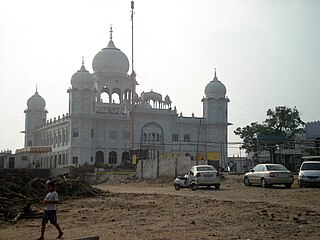
Nada Sahib is a Sikh gurudwara in the Panchkula district of the Indian state of Haryana. Situated on the banks of the Ghaggar-Hakra River in the Sivalik Hills of Panchkula, it is the site where Guru Gobind Singh Ji halted while travelling from Paonta Sahib to Anandpur Sahib after the Battle of Bhangani in 1688.

German Sikhs are a growing religious minority in Germany. The majority of German Sikhs have their roots from the Punjab, India with the remaining coming from the Afghan Sikh community or through conversion. The number of Sikhs is estimated to be between 25,000. Germany had the fifth highest Sikh population in Europe after United Kingdom (524,000), Italy (220,000), Portugal (35,000) and Spain (26,000).
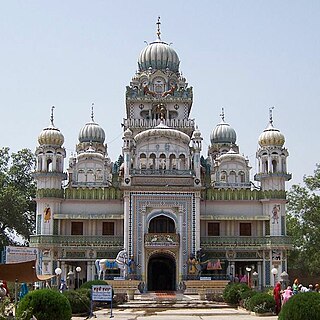
Gurdwara Mehdiana Sahib, also called the 'School of Sikh History' is a Sikh gurdwara located in the village of Mehdiana, just outside Mallha, near Jagraon in Ludhiana district, India.
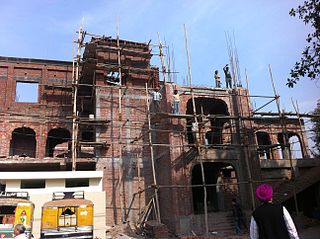
Dugri is a village in the Indian state of Punjab.
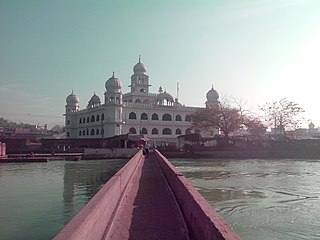
Kiratpur, also known as Kiratpur Sahib, is a town, just 30 km from Rupnagar city in Rupnagar district of Punjab, India. The town is the location of the Gurdwara Patal Puri where many Sikhs take ashes of their deceased.
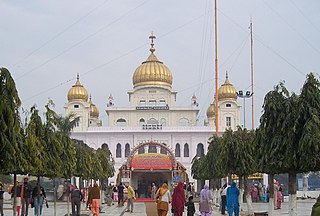
Gurdwara Fatehgarh Sahib is a Sikh gurdwara or place of worship in the city of Fatehgarh Sahib in the Indian state of Punjab. The gurdwara marks the 1710 conquest of the city by the Sikhs under the leadership of Banda Singh Bahadur. Sikhs captured the area and razed the fort built by Ferozshah Tughlaq to the ground.

Hazur Sahib, also known as Takht Sachkhand Sri Hazur Abchalnagar Sahib, is one of the five takhts in Sikhism. The gurdwara was built between 1832 and 1837 by Maharaja Ranjit Singh (1780–1839). It is located on the banks of the Godavari River at the city of Nanded in the state of Maharashtra, India.
A takht, or taḵẖat, literally means a throne or seat of authority and is a spiritual and temporal centre of Sikhism. There are five takhts, which are five gurudwaras that have a very special significance for the Sikh community. Three are located in Punjab whilst the remaining two are located outside of it.

The 350th Prakash Parv or birth anniversary of Guru Gobind Singh ji was celebrated in January 2017 in Patna, India. 2017 is the year of the 350th anniversary of the 10th Sikh Guru, a spiritual master, warrior, poet and philosopher. At the date of this anniversary, a number of events was organized on the occasion in Patna marking a grand celebration in their history.



















